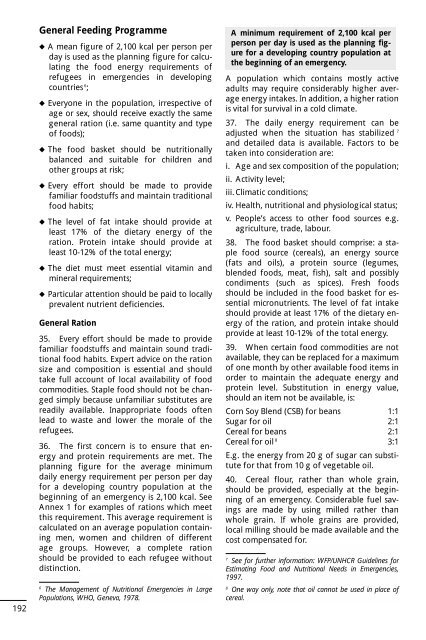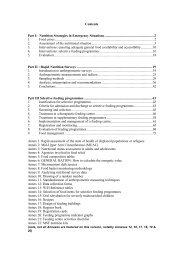UNHCR Handbook for Emergencies - UNHCR eCentre
UNHCR Handbook for Emergencies - UNHCR eCentre
UNHCR Handbook for Emergencies - UNHCR eCentre
You also want an ePaper? Increase the reach of your titles
YUMPU automatically turns print PDFs into web optimized ePapers that Google loves.
192<br />
General Feeding Programme<br />
◆ A mean figure of 2,100 kcal per person per<br />
day is used as the planning figure <strong>for</strong> calculating<br />
the food energy requirements of<br />
refugees in emergencies in developing<br />
countries 6 ;<br />
◆ Everyone in the population, irrespective of<br />
age or sex, should receive exactly the same<br />
general ration (i.e. same quantity and type<br />
of foods);<br />
◆ The food basket should be nutritionally<br />
balanced and suitable <strong>for</strong> children and<br />
other groups at risk;<br />
◆ Every ef<strong>for</strong>t should be made to provide<br />
familiar foodstuffs and maintain traditional<br />
food habits;<br />
◆ The level of fat intake should provide at<br />
least 17% of the dietary energy of the<br />
ration. Protein intake should provide at<br />
least 10-12% of the total energy;<br />
◆ The diet must meet essential vitamin and<br />
mineral requirements;<br />
◆ Particular attention should be paid to locally<br />
prevalent nutrient deficiencies.<br />
General Ration<br />
35. Every ef<strong>for</strong>t should be made to provide<br />
familiar foodstuffs and maintain sound traditional<br />
food habits. Expert advice on the ration<br />
size and composition is essential and should<br />
take full account of local availability of food<br />
commodities. Staple food should not be changed<br />
simply because unfamiliar substitutes are<br />
readily available. Inappropriate foods often<br />
lead to waste and lower the morale of the<br />
refugees.<br />
36. The first concern is to ensure that energy<br />
and protein requirements are met. The<br />
planning figure <strong>for</strong> the average minimum<br />
daily energy requirement per person per day<br />
<strong>for</strong> a developing country population at the<br />
beginning of an emergency is 2,100 kcal. See<br />
Annex 1 <strong>for</strong> examples of rations which meet<br />
this requirement. This average requirement is<br />
calculated on an average population containing<br />
men, women and children of different<br />
age groups. However, a complete ration<br />
should be provided to each refugee without<br />
distinction.<br />
6 The Management of Nutritional <strong>Emergencies</strong> in Large<br />
Populations, WHO, Geneva, 1978.<br />
A minimum requirement of 2,100 kcal per<br />
person per day is used as the planning figure<br />
<strong>for</strong> a developing country population at<br />
the beginning of an emergency.<br />
A population which contains mostly active<br />
adults may require considerably higher average<br />
energy intakes. In addition, a higher ration<br />
is vital <strong>for</strong> survival in a cold climate.<br />
37. The daily energy requirement can be<br />
adjusted when the situation has stabilized 7<br />
and detailed data is available. Factors to be<br />
taken into consideration are:<br />
i. Age and sex composition of the population;<br />
ii. Activity level;<br />
iii. Climatic conditions;<br />
iv. Health, nutritional and physiological status;<br />
v. People’s access to other food sources e.g.<br />
agriculture, trade, labour.<br />
38. The food basket should comprise: a staple<br />
food source (cereals), an energy source<br />
(fats and oils), a protein source (legumes,<br />
blended foods, meat, fish), salt and possibly<br />
condiments (such as spices). Fresh foods<br />
should be included in the food basket <strong>for</strong> essential<br />
micronutrients. The level of fat intake<br />
should provide at least 17% of the dietary energy<br />
of the ration, and protein intake should<br />
provide at least 10-12% of the total energy.<br />
39. When certain food commodities are not<br />
available, they can be replaced <strong>for</strong> a maximum<br />
of one month by other available food items in<br />
order to maintain the adequate energy and<br />
protein level. Substitution in energy value,<br />
should an item not be available, is:<br />
Corn Soy Blend (CSB) <strong>for</strong> beans 1:1<br />
Sugar <strong>for</strong> oil 2:1<br />
Cereal <strong>for</strong> beans 2:1<br />
Cereal <strong>for</strong> oil 8 3:1<br />
E.g. the energy from 20 g of sugar can substitute<br />
<strong>for</strong> that from 10 g of vegetable oil.<br />
40. Cereal flour, rather than whole grain,<br />
should be provided, especially at the beginning<br />
of an emergency. Considerable fuel savings<br />
are made by using milled rather than<br />
whole grain. If whole grains are provided,<br />
local milling should be made available and the<br />
cost compensated <strong>for</strong>.<br />
7 See <strong>for</strong> further in<strong>for</strong>mation: WFP/<strong>UNHCR</strong> Guidelines <strong>for</strong><br />
Estimating Food and Nutritional Needs in <strong>Emergencies</strong>,<br />
1997.<br />
8 One way only, note that oil cannot be used in place of<br />
cereal.



